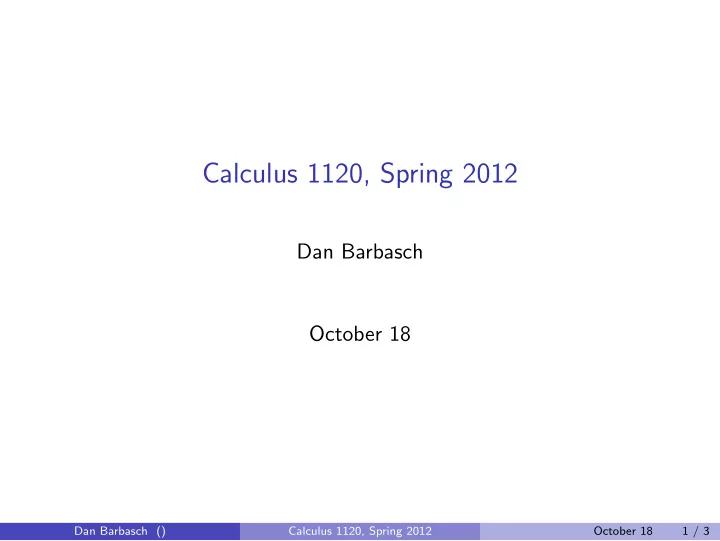

Calculus 1120, Spring 2012 Dan Barbasch October 18 Dan Barbasch () Calculus 1120, Spring 2012 October 18 1 / 3
First Order Equations y ′ = f ( x , y ) A first order differential equation Initial Value Problem: Find a solution to a first order equation satisfying the extra condition y ( x 0 ) = y 0 . Dan Barbasch () Calculus 1120, Spring 2012 October 18 2 / 3
First Order Equations Motivation/Examples: 1 Exponential Growth/Decay, population growth/radioactive decay/interest 2 Logistic Equation 3 Circuits 4 Newton’s Law of Cooling 5 Motion with resistance proportional to velocity 6 Mixture Problems Dan Barbasch () Calculus 1120, Spring 2012 October 18 2 / 3
First Order Equations Solving Equations: Finding solutions directly, separable/linear equations Graphical Methods, slope fields Numerical Methods, Euler’s Method Dan Barbasch () Calculus 1120, Spring 2012 October 18 2 / 3
Graphical Method Finding an explicit solution is often not possible. There is a graphical way to get a sense of what the solutions look like. A solution curve y ( x ) to the equation y ′ = f ( x , y ) has slope of the tangent line at any point ( x , y ) equal to f ( x , y ) . Draw a small line at each ( x , y ) with slope f ( x , y ) . This is called the slope field (direction field) of the equation. Choose a starting point, and sketch a curve whose tangent at each point is the slope field. These lines give you a qualitative sense of what the solutions look like. Dan Barbasch () Calculus 1120, Spring 2012 October 18 3 / 3
Graphical Method dP dt = P (1 − P ) When drawing a slope field, identify the regions where f ( x , y ) > 0 , and where f ( x , y ) < 0 . The solutions are increasing and decreasing respectively in these regions. At a point ( x 0 , y 0 ) where the function f ( x , y ) = 0 the slope of the tangent line is flat. In this example, the function f ( t , P ) = f ( P ) is independent of t . Equations y ′ = g ( y ) are called autonomous . For such an equation, if g ( y 0 ) = 0 , then y = y 0 is a solution. It is called an equilibrium. In the example, P ( t ) = 0 and P ( t ) = 1 are equilibriums. P = 1 is stable, P = 0 is unstable. A basic theorem about differential equations says that if f ( x , y ) is continuous in x and y , and continuously differentiable in y , then the solutions do not intersect. Same as saying that the equation has a unique solution with a given initial condition. Dan Barbasch () Calculus 1120, Spring 2012 October 18 3 / 3
Graphical Method dP dt = P (1 − P ) Dan Barbasch () Calculus 1120, Spring 2012 October 18 3 / 3
Graphical Method dP dt = P (1 − P ) P 0 e t P 0 Solution: P = P 0 +(1 − P 0 ) e − t = 1+ P 0 ( e t − 1) . 2 P 0 = 2 , P ( t ) = 2 − e − t , t > − ln 2! P ( t ) = 1 1 1 P 0 = 1 / 2 , 1 / 2 + e − t / 2 = −∞ < t < ∞ 1 + e − t 2 − 1 1 P 0 = − 1 , P ( t ) = − 1 + 2 e − t = t < ln 2! 1 − 2 e − t The last equation has a vertical asymptote t < ln 2! WARNING: There is NO long term behaviour for this solution. In general for P 0 < 0 , t < ln 1 − P 0 − P 0 Dan Barbasch () Calculus 1120, Spring 2012 October 18 3 / 3
Graphical Method dy dx = y 2 − x 2 . Dan Barbasch () Calculus 1120, Spring 2012 October 18 3 / 3
Graphical Method dy dx = y 2 − x 2 . Dan Barbasch () Calculus 1120, Spring 2012 October 18 3 / 3
Graphical Method y ′ = − y + 1 You can find a program that draws the slope field and solutions of an ODE y ′ = f ( x , y ) at http://math.rice.edu/˜dfield/dfpp.html Dan Barbasch () Calculus 1120, Spring 2012 October 18 3 / 3
Recommend
More recommend